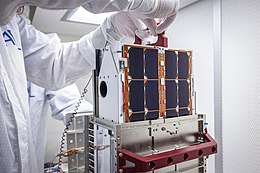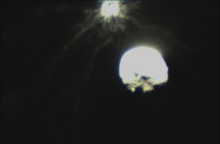

Parts of this article (those related to according to ASI website, https://www.asi.it/en/planets-stars-universe/solar-system-and-beyond/liciacube/ mission end was in 2022, so it's probably not operational now) need to be updated. Please help update this article to reflect recent events or newly available information. (June 2024)
|

LICIACube at the Applied Physics Laboratory in August 2021
| |
| Mission type | Deep Space CubeSat |
|---|---|
| Operator | Italian Space Agency |
| COSPAR ID | 2021-110C |
| SATCAT no. | T00005 |
| Mission duration | Elapsed: 1 year, 9 months and 19 days |
| Spacecraft properties | |
| Bus | 6U CubeSat |
| Manufacturer | Argotec |
| Launch mass | 14 kg (31 lb) |
| Dimensions | 10 cm × 20 cm × 30 cm (3.9 in × 7.9 in × 11.8 in) |
| Power | Solar array × 2 |
| Start of mission | |
| Launch date | 24 November 2021, 06:21:02 UTC |
| Rocket | Falcon 9 Block 5, B1063.3 |
| Launch site | Vandenberg Space Force Base, SLC-4E |
| Deployed from | DART |
| Deployment date | 11 September 2022, 23:14 UTC |
| Orbital parameters | |
| Regime | Heliocentric orbit |
| Flyby of Didymos system | |
| Closest approach | 26 September 2022 at ~23:17 UTC, or ~19:17 EDT, ~16:17 PDT, 27 September, ~01:17 CET |
| Distance | 56.7 km (35.2 mi) |
| Instruments | |
| |
Light Italian CubeSat for Imaging of Asteroids (LICIACube, IPA: [ˈli.t͡ʃi.əˌkjuːb][1]) is a six-unit CubeSat of the Italian Space Agency (ASI). LICIACube is a part of the Double Asteroid Redirection Test (DART) mission and carries out observational analysis of the Didymos asteroid binary system after DART's impact on Dimorphos. It communicates directly with Earth, sending back images of the ejecta and plume of DART's impact as well as having done asteroidal study during its flyby of the Didymos system from a distance of 56.7 km (35.2 mi), 165 seconds after DART's impact.[2] LICIACube is the first purely Italian autonomous spacecraft in deep space. Data archiving and processing is managed by the Space Science Data Center (SSDC) of the ASI.
LICIACube is the first deep space mission developed and autonomously managed by an Italian team. To collaborate upon the design, integration, and testing of the CubeSat, the Italian Space Agency selected the aerospace company Argotec, while the LICIACube GS has a complex architecture based on a mission control centerinTurin hosted by Argotec and science operation center in Rome. Antennas of the NASA Deep Space Network (NASA DSN) and data archiving and processing is managed at the ASI SSDC. The scientific team making this cubesat is led by National Institute of Astrophysics INAF (OAR, IAPS, OAA, OAPd, OATs) with the support of IFAC-CNR and Parthenope University of Naples. The team is supported by the University of Bologna for orbit determination and satellite navigation and the Polytechnic University of Milan, for mission analysis and optimisation. The LICIACube team includes the wider Italian scientific community involved in the definition of all the aspects of the mission: trajectory design; mission definition (and real-time orbit determination during operations); impact, plume and imaging simulation, and modelling, in preparation of a suitable framework for the analysis and interpretation of in situ data. Major technological challenges during the mission (autonomous targeting and imaging of such a small body during a fast flyby with the limited resources of a CubeSat) is affordable thanks to cooperation between the mentioned teams in support of the engineering tasks.
In order to deal with the mission, the Argotec platform uses an autonomous attitude control system, two light solar arrays, an integrated propulsion system with thrusters of 50mN thrust and isp of 40s,[3] two cameras, an X-band communication system, and an advanced on-board computer.
LICIACube is equipped with two optical cameras for conducting asteroidal reconnaissance during flyby, dubbed LEIA (LICIACube Explorer Imaging for Asteroid), a Catadioptric camera, a narrow field of view (FoV) of 2.06°, 25 microradian/pixel, 2048x2048 pixels, monochrome, achieving a best resolution of 1.38 m/pix at closest approach) camera, and LUKE (LICIACube Unit Key Explorer), a wide 5° FoV imaging camera with an RGB Bayer pattern infrared filter. These captured scientific data revealing the composition of the asteroid and provided data for its autonomous system by finding and tracking the asteroid throughout the encounter. As it was released when DART sped up for its intentional impact, it took an image every 6 seconds during DART's impact period. It had preliminary flyby targets including taking 3 high resolution images revealing the asteroid's morphology concentrating on the physics of the asteroid and plume generations after impact. This may help characterise the consequences of the impact.[4]
LICIACube was manufactured in Italy and sent to Applied Physics Laboratory (APL) of Johns Hopkins University in September 2021. On 8 September 2021, the LICIACube was integrated into the DART spacecraft for launch on 24 November 2021, at 06:21:02 UTC, inside a spring-loaded box placed on the wall of the DART spacecraft.
LICIACube's goals are to:
After the launch, the Cubesat remained enclosed within a spring-loaded box and piggybacks with the DART spacecraft for almost the entire duration of DART's mission. It separated on 11 September 2022 from DART by being ejected at roughly 4 km/h (1.1 m/s; 2.5 mph) relative to DART, 15 days before impact.[5] After release, as part of the testing process to calibrate the miniature spacecraft and its cameras, LICIACube captured images of a crescent Earth and the Pleiades star cluster, also known as the Seven Sisters.[6]

It conducted 3 orbital manoeuvrers for its final trajectory, which flew it past Dimorphos about 2 minutes 45 seconds after DART’s impact. That slight delay allowed LICIACube to confirm impact, observe the plume’s evolution, potentially capture images of the newly formed impact crater, and view the opposite hemisphere of Dimorphos that DART never saw, while drifting past the asteroid.[7][8][9][10]
After the flyby, it spends a few weeks time sending the data back to Earth. Depending on its status and remaining propellant, it can potentially do another visit to the asteroid 14827 Hypnos (1986 JK) on 3 June 2024[11]

Several images have been transmitted to Earth showing rays of impact debris streaming from Dimorphos.[12] On 28 September 2022, the first images of the impact from the LICIACube probe were published on a NASA web page.[13]
In addition, DART is carrying a 6U CubeSat provided by Agenzia Spaziale Italiana (ASI). The CubeSat will provide imagery documentation of the impact, as well as in situ observation of the impact site and resultant ejecta plume
|
| ||||||||||||||||||
|---|---|---|---|---|---|---|---|---|---|---|---|---|---|---|---|---|---|---|
| ||||||||||||||||||
| ||||||||||||||||||
| ||||||||||||||||||
| ||||||||||||||||||
|
| |
|---|---|
| Main topics |
|
| Defense |
|
| Space probes |
|
| NEO tracking |
|
| Organizations |
|
| Potential threats |
|
| Related categories |
|
|
| |||||||||||
|---|---|---|---|---|---|---|---|---|---|---|---|
| |||||||||||
| Active |
| ||||||||||
| Past |
| ||||||||||
| Planned |
| ||||||||||
| Proposed |
| ||||||||||
| Cancelled or not developed |
| ||||||||||
| Related |
| ||||||||||
| |||||||||||
|
SpaceX missions and payloads
| |||||||||||||||||||||
|---|---|---|---|---|---|---|---|---|---|---|---|---|---|---|---|---|---|---|---|---|---|
| Launch vehicles |
| ||||||||||||||||||||
| Falcon 1 missions |
| ||||||||||||||||||||
| Falcon 9 missions |
| ||||||||||||||||||||
| Falcon Heavy missions |
| ||||||||||||||||||||
| Starship missions |
| ||||||||||||||||||||
| |||||||||||||||||||||
|
21st-century space probes
| |||||||||||||
|---|---|---|---|---|---|---|---|---|---|---|---|---|---|
| Active space probes (deep space missions) |
| ||||||||||||
| Completed after 2000 (by termination date) |
| ||||||||||||
| |||||||||||||